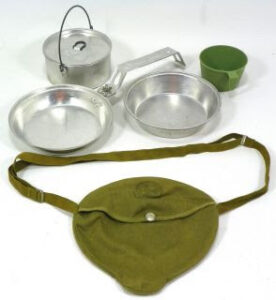Continuing the discussion of cookware. In the 1921 edition of Horace Kephart’s book he makes the following statement in the second volume:
“It is easy to make up a good lightweight set of utensils for two or more men (see Vol. I. pp. 118-123), but a satisfactory one-man kit is another matter. The Boy Scout sets do fairly well for a short outing when baked bread is carried, but are inadequate for baking on the journey. A reflector is too cumbersome for a lone woods-cruiser. Let him bake his bread and cakes in a frying-pan (see Vol. I, pp. 344-345). This calls for an 8 or 9-inch pan.”
Camping and Woodcraft Vol.2, p.102
I do not know for sure the exact form of the Boy Scout set to which Kephart was referring. I suspect it was not that different to the kits in use in the 1950s. Over two million of these were produced so they were in production for a long time. Quite a few of these kits are offered from sources such as ebay. A tip is to try searching for “BSA” (Boy Scouts of America). Also try GSA or “Guide cook/mess kit”. I’ve also come across “non-official” mess kits that are clearly based on or inspired by these kits.
The kit includes a frying pan and a metal plate which fit together to form a unit that looks rather like the water bottles you see in Westerns. The folding frying pan handle secures the two together and this fits in a canvas bag. More modern versions often have a mesh bag. Inside the package fits a billy, and inside the billy is a drinking cup. In older versions the cup is metal, in more modern renditions it may be plastic. 

The best feature of this kit is that it has a real billy. It has a handle by which it can be suspended above a fire and a lid to keep the dirt and insects out. On the original versions the lid has a folding ring, allowing the lid to be lifted with a stick while the billy is over a blazing fire. More modern examples have a more conventional (and less desirable) plastic knob. Fitting a ring or loop is recommended. The capacity of the pot is apparently 1¾ quarts, which is a fairly good size for a pot if you only have one. Shape is low and broad, suggesting a more efficient use of heat sources and easy cleaning.
The billy fits between the plate and frying pan, which means you can potentially contaminate the insides of these vessels with the pot bottom. Keeping the billy in its own bag would be prudent although one would have to ensure the bulk of this does not prevent the parts fitting together. Having the billy in contact with the inside of the pan may also explain why no non-stick version of the frying pan has been offered.
The plate is metal and I have heard criticisms that this allows the food to cool too quickly. Personally I have found that an outdoors appetite seldom allows food time to get cold! I can see that the metal plate might be uncomfortable to hold if hot, however. Some clever bunny should offer a plastic replacement for these kits! The frying pan is a little on the small side, hence Kephart’s comment that this is a good kit if you do not have to bake. There are criticisms that the bolt that holds the handle on works loose. Adopt the habit of routinely checking and tightening it whenever you handle it.
The scout cook kit is made of aluminium so this might be an opportune moment to discuss this material for cooking purposes. This Canadian Health site gives a nice account of the pros and cons of different materials. The key to cooking safely with aluminium vessels lies in understanding the acidity of the foods you cook. “Naked” aluminium is actually coated with a layer of aluminium oxide. As long as this is intact you should have no worries. Acidic foods or sauces will dissolve this protective coating. So too will rough scrubbing if the vessel is not left long enough for a new protective layer to form. Aluminium will react to form oxide with the oxygen in the air or water. I suspect boiling some water in a vessel will speed this reaction up. Acid foodstuffs to be cautious of include tomatoes, fruit juices and vinegar. Reserve these until your food is cooked or in an non-aluminium vessel. The above refers to “naked aluminium”. Anodised or non-stick coated vessels are not a problem unless the coating is damaged.
Many more modern versions of camping cookware or mess kits have moved towards the use of stainless steel. This is heavier but more “soldier proof” and needs less care to use safely.